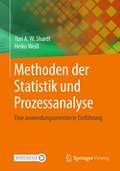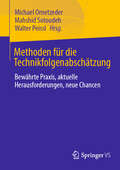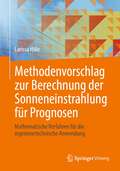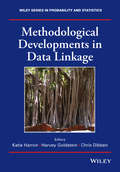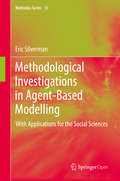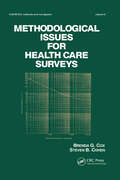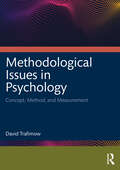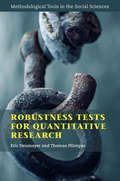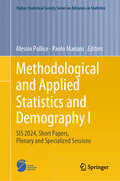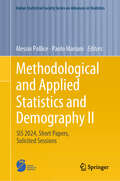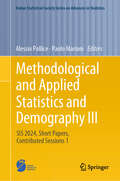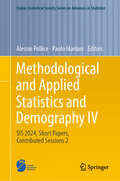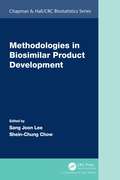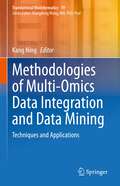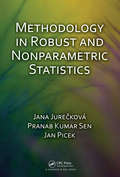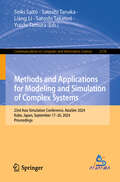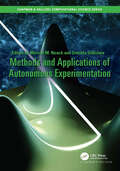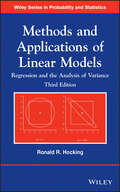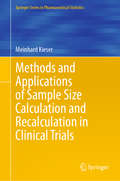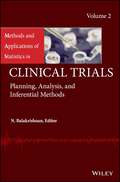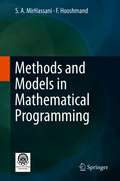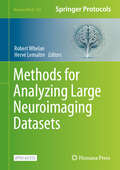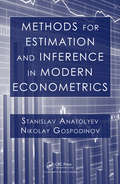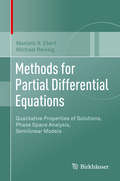- Table View
- List View
Methoden der Statistik und Prozessanalyse: Eine anwendungsorientierte Einführung
by Yuri Shardt Heiko WeißDieses Buch konzentriert sich auf die Anwendung von modernen Methoden derStatistik zur Modellierung und Analyse von Prozessmodellen der Verfahrenstechnik.Beispiele für moderne Methoden sind Matrixansätze, im Gegensatz zumanuellen Berechnungen, sowie das Konzept orthogonaler Basen. Diese Ansätzeermöglichen eine computergestützte Analyse von Versuchsplänen.Zunächst werden die wichtigsten Aspekte und Methoden der Statistik und Prozessanalysevorgestellt. Auf dieserGrundlage werden anschließend komplexere Methoden für die Anwendungerarbeitet. Hierbei legen die Autoren großen Wert auf eine kurze, jedoch umfassendeund konsistente Darstellung.Zur Erleichterung der Implementierung werden detaillierte Vorgehensweisen fürdie relevanten Konzepte vorgestellt und anhand geeigneter Beispiele vorgestellt. Die Beispiele sind so gewählt, dass sie mit vorhandenen Softwarewerkzeugen (Matlab, Excel) nachgebildet werden können. Für diesen Zweck werden Excel-Vorlagen undMATLAB-Programme bereitgestellt. Ein ausführliches deutsch-englisches Glossar ist ebenfalls enthalten.
Methoden für die Technikfolgenabschätzung: Bewährte Praxis, aktuelle Herausforderungen, neue Chancen
by Walter Peissl Michael Ornetzeder Mahshid SotoudehMethoden sind für die Technikfolgenabschätzung (TA) von zentraler Bedeutung. Wissen über Folgen und Risiken von Technik muss erzeugt, diskutiert, bewertet und vermittelt werden. Die TA greift dabei auf eine Vielzahl von wissensgenerierenden, kollaborativen und kommunikativen Methoden zurück, wobei sich diese ständig weiterentwickeln und neue Methoden hinzukommen. Das Buch reflektiert den aktuellen Stand der Methodendiskussion in der TA und diskutiert zukünftige Herausforderungen. In fünf thematischen Abschnitten werden die Themen „Anspruch der Methoden in der TA&”, „konzeptionelle Überlegungen&”, „künstliche Intelligenz als Thema und Methode der TA&”, „Methoden im Transformationskontext&” sowie „methodische Innovationen&” behandelt. Die Beiträge in diesem Sammelband zielen darauf ab, die methodischen Grundlagen in der TA weiterzuentwickeln und damit ihre Bedeutung für die Gestaltung der Zukunft zu stärken.
Methodenvorschlag zur Berechnung der Sonneneinstrahlung für Prognosen: Mathematische Verfahren für die ingenieurtechnische Anwendung
by Larissa HilleIn diesem Buch werden mathematische Verfahren zur Lösung folgender Aufgaben vorgestellt:(Absatz)- Berechnen der Sonnenposition;(Absatz)- Berechnen der Leistung, die ein Lichtstrahl auf seinem Weg durch die Atmosphäre durch Absorption und Streuung verliert;(Absatz)- Berechnen der Strahlenverteilung in einer Wolkenschicht;(Absatz)- Berechnen diffuser Strahlung, die aus einer Atmosphärenschicht bei einer vorgegebenen Verteilung der gestreuten Strahlung zu einer ebenen Oberfläche (Solarmodul) oder zur Seitenfläche eines stehenden Kegelstumpfs (Windkraftanlagenturm) gestreut wird und diese Fläche in bestimmten Winkeln trifft.
Methodological Developments in Data Linkage: Methodological Developments (Wiley Series in Probability and Statistics #999)
by Harvey Goldstein Katie Harron Chris DibbenA comprehensive compilation of new developments in data linkage methodology The increasing availability of large administrative databases has led to a dramatic rise in the use of data linkage, yet the standard texts on linkage are still those which describe the seminal work from the 1950-60s, with some updates. Linkage and analysis of data across sources remains problematic due to lack of discriminatory and accurate identifiers, missing data and regulatory issues. Recent developments in data linkage methodology have concentrated on bias and analysis of linked data, novel approaches to organising relationships between databases and privacy-preserving linkage. Methodological Developments in Data Linkage brings together a collection of contributions from members of the international data linkage community, covering cutting edge methodology in this field. It presents opportunities and challenges provided by linkage of large and often complex datasets, including analysis problems, legal and security aspects, models for data access and the development of novel research areas. New methods for handling uncertainty in analysis of linked data, solutions for anonymised linkage and alternative models for data collection are also discussed. Key Features: Presents cutting edge methods for a topic of increasing importance to a wide range of research areas, with applications to data linkage systems internationally Covers the essential issues associated with data linkage today Includes examples based on real data linkage systems, highlighting the opportunities, successes and challenges that the increasing availability of linkage data provides Novel approach incorporates technical aspects of both linkage, management and analysis of linked data This book will be of core interest to academics, government employees, data holders, data managers, analysts and statisticians who use administrative data. It will also appeal to researchers in a variety of areas, including epidemiology, biostatistics, social statistics, informatics, policy and public health.
Methodological Investigations in Agent-Based Modelling: With Applications For The Social Sciences (Methodos Ser. #13)
by Daniel Courgeau Jakub Bijak John Bryden Eric Silverman Robert Franck Jason Hilton Jason NobleThis open access book examines the methodological complications of using complexity science concepts within the social science domain. The opening chapters take the reader on a tour through the development of simulation methodologies in the fields of artificial life and population biology, then demonstrates the growing popularity and relevance of these methods in the social sciences. Following an in-depth analysis of the potential impact of these methods on social science and social theory, the text provides substantive examples of the application of agent-based models in the field of demography. This work offers a unique combination of applied simulation work and substantive, in-depth philosophical analysis, and as such has potential appeal for specialist social scientists, complex systems scientists, and philosophers of science interested in the methodology of simulation and the practice of interdisciplinary computing research.
Methodological Issues for Health Care Surveys (Statistics: A Series of Textbooks and Monographs)
by B. M. CoxThis book is written for professionals who wish to learn about methodological issues associated with health care surveys. It represents a distinct and important contribution to the application of the methodology of sample surveys to the collection of data on the utilization of health care services.
Methodological Issues in Psychology: Concept, Method, and Measurement
by David TrafimowMethodological Issues in Psychology is a comprehensive text that challenges current practice in the discipline and provides solutions that are more useful in contemporary research, both basic and applied. This book begins by equipping the readers with the underlying foundation pertaining to basic philosophical issues addressing theory verification or falsification, distinguishing different levels of theorizing, or hypothesizing, and the assumptions necessary to negotiate between these levels. It goes on to specifically focus on statistical and inferential hypotheses including chapters on how to dramatically improve statistical and inferential practices and how to address the replication crisis. Advances to be featured include the author's own inventions, the a priori procedure and gain-probability diagrams, and a chapter about mediation analyses, which explains why such analyses are much weaker than typically assumed. The book also provides an introductory chapter on classical measurement theory and expands to new concepts in subsequent chapters. The final measurement chapter addresses the ubiquitous problem of small effect sizes in psychology and provides recommendations that directly contradict typical thinking and teaching in psychology, but with the consequence that researchers can enjoy dramatically improved effect sizes. Methodological Issues in Psychology is an invaluable asset for students and researchers of psychology. It will also be of vital interest to social science researchers and students in areas such as management, marketing, sociology, and experimental philosophy.
Methodological Tools in the Social Sciences: Robustness Tests for Quantitative Research (Methodological Tools in the Social Sciences)
by Eric Neumayer Thomas PlümperThe uncertainty that researchers face in specifying their estimation model threatens the validity of their inferences. In regression analyses of observational data, the 'true model' remains unknown, and researchers face a choice between plausible alternative specifications. Robustness testing allows researchers to explore the stability of their main estimates to plausible variations in model specifications. This highly accessible book presents the logic of robustness testing, provides an operational definition of robustness that can be applied in all quantitative research, and introduces readers to diverse types of robustness tests. Focusing on each dimension of model uncertainty in separate chapters, the authors provide a systematic overview of existing tests and develop many new ones. Whether it be uncertainty about the population or sample, measurement, the set of explanatory variables and their functional form, causal or temporal heterogeneity, or effect dynamics or spatial dependence, this book provides guidance and offers tests that researchers from across the social sciences can employ in their own research.
Methodological and Applied Statistics and Demography I: SIS 2024, Short Papers, Plenary and Specialized Sessions (Italian Statistical Society Series on Advances in Statistics)
by Paolo Mariani Alessio PolliceThis book of peer-reviewed short papers on methodological and applied statistics and demography is the first of four volumes from the 52nd Scientific Meeting of the Italian Statistical Society (SIS 2024), held in Bari, Italy, on June 17-20, 2024. It features invited contributions presented in the Plenary and Specialized Sessions. The volumes address a large number of topics and applications of current interest. The topics covered include, but are not limited to, statistical theory and methods, sampling theory, Bayesian statistics, statistical modeling, computational statistics, classification, data analysis, gender statistics and applied statistics. The applications reflect new analyses in a wide variety of fields, including demography, psychometrics, education, business, economics, finance, law, and other social sciences and humanities, epidemiology, the life and health sciences as well as the environmental and natural sciences and engineering. This variety also demonstrates the important role of statistical science in addressing the societal and environmental challenges of sustainable development. One of the aims of the Italian Statistical Society (SIS) is to promote scientific activities for the development of statistical sciences. Its biennial international Scientific Meeting represents the Society’s largest event which brings together national and international researchers and professionals to exchange ideas and discuss recent advances and developments in theoretical and applied statistics.
Methodological and Applied Statistics and Demography II: SIS 2024, Short Papers, Solicited Sessions (Italian Statistical Society Series on Advances in Statistics)
by Paolo Mariani Alessio PolliceThis book of peer-reviewed short papers on methodological and applied statistics and demography is the second of four volumes from the 52nd Scientific Meeting of the Italian Statistical Society (SIS 2024), held in Bari, Italy, on June 17-20, 2024. It features invited contributions presented in the Solicited Sessions. The volumes address a large number of topics and applications of current interest. The topics covered include, but are not limited to, statistical theory and methods, sampling theory, Bayesian statistics, statistical modeling, computational statistics, classification, data analysis, gender statistics and applied statistics. The applications reflect new analyses in a wide variety of fields, including demography, psychometrics, education, business, economics, finance, law, and other social sciences and humanities, epidemiology, the life and health sciences as well as the environmental and natural sciences and engineering. This variety also demonstrates the important role of statistical science in addressing the societal and environmental challenges of sustainable development. One of the aims of the Italian Statistical Society (SIS) is to promote scientific activities for the development of statistical sciences. Its biennial international Scientific Meeting represents the Society’s largest event which brings together national and international researchers and professionals to exchange ideas and discuss recent advances and developments in theoretical and applied statistics.
Methodological and Applied Statistics and Demography III: SIS 2024, Short Papers, Contributed Sessions 1 (Italian Statistical Society Series on Advances in Statistics)
by Paolo Mariani Alessio PolliceThis book of peer-reviewed short papers on methodological and applied statistics and demography is the third of four volumes from the 52nd Scientific Meeting of the Italian Statistical Society (SIS 2024), held in Bari, Italy, on June 17-20, 2024. It features the first part of the contributions presented in the Contributed Sessions. The volumes address a large number of topics and applications of current interest. The topics covered include, but are not limited to, statistical theory and methods, sampling theory, Bayesian statistics, statistical modeling, computational statistics, classification, data analysis, gender statistics and applied statistics. The applications reflect new analyses in a wide variety of fields, including demography, psychometrics, education, business, economics, finance, law, and other social sciences and humanities, epidemiology, the life and health sciences as well as the environmental and natural sciences and engineering. This variety also demonstrates the important role of statistical science in addressing the societal and environmental challenges of sustainable development. One of the aims of the Italian Statistical Society (SIS) is to promote scientific activities for the development of statistical sciences. Its biennial international Scientific Meeting represents the Society’s largest event which brings together national and international researchers and professionals to exchange ideas and discuss recent advances and developments in theoretical and applied statistics.
Methodological and Applied Statistics and Demography IV: SIS 2024, Short Papers, Contributed Sessions 2 (Italian Statistical Society Series on Advances in Statistics)
by Paolo Mariani Alessio PolliceThis book of peer-reviewed short papers on methodological and applied statistics and demography is the fourth of four volumes from the 52nd Scientific Meeting of the Italian Statistical Society (SIS 2024), held in Bari, Italy, on June 17-20, 2024. It features the second part of the contributions presented in the Contributed Sessions. The volumes address a large number of topics and applications of current interest. The topics covered include, but are not limited to, statistical theory and methods, sampling theory, Bayesian statistics, statistical modeling, computational statistics, classification, data analysis, gender statistics and applied statistics. The applications reflect new analyses in a wide variety of fields, including demography, psychometrics, education, business, economics, finance, law, and other social sciences and humanities, epidemiology, the life and health sciences as well as the environmental and natural sciences and engineering. This variety also demonstrates the important role of statistical science in addressing the societal and environmental challenges of sustainable development. One of the aims of the Italian Statistical Society (SIS) is to promote scientific activities for the development of statistical sciences. Its biennial international Scientific Meeting represents the Society’s largest event which brings together national and international researchers and professionals to exchange ideas and discuss recent advances and developments in theoretical and applied statistics.
Methodologies in Biosimilar Product Development (Chapman & Hall/CRC Biostatistics Series)
by Shein-Chung Chow Sang Joon LeeMethodologies for Biosimilar Product Development covers the practical and challenging issues that are commonly encountered during the development, review, and approval of a proposed biosimilar product. These practical and challenging issues include, but are not limited to the mix-up use of interval hypotheses testing (i.e., the use of TOST) and confidence interval approach, a risk/benefit assessment for non-inferiority/similarity margin, PK/PD bridging studies with multiple references, the detection of possible reference product change over time, design and analysis of biosimilar switching studies, the assessment of sensitivity index for assessment of extrapolation across indications without collecting data from those indications not under study, and the feasibility and validation of non-medical switch post-approval. Key Features: Reviews withdrawn draft guidance on analytical similarity assessment. Evaluates various methods for analytical similarity evaluation based on FDA’s current guidelines. Provides a general approach for the use of n-of-1 trial design for assessment of interchangeability. Discusses the feasibility and validity of the non-medical switch studies. Provides innovative thinking for detection of possible reference product change over time. This book embraces innovative thinking of design and analysis for biosimilar studies, which are required for review and approval of biosimilar regulatory submissions.
Methodologies of Multi-Omics Data Integration and Data Mining: Techniques and Applications (Translational Bioinformatics #19)
by Kang NingThis book features multi-omics big-data integration and data-mining techniques. In the omics age, paramount of multi-omics data from various sources is the new challenge we are facing, but it also provides clues for several biomedical or clinical applications. This book focuses on data integration and data mining methods for multi-omics research, which explains in detail and with supportive examples the “What”, “Why” and “How” of the topic. The contents are organized into eight chapters, out of which one is for the introduction, followed by four chapters dedicated for omics integration techniques focusing on several omics data resources and data-mining methods, and three chapters dedicated for applications of multi-omics analyses with application being demonstrated by several data mining methods. This book is an attempt to bridge the gap between the biomedical multi-omics big data and the data-mining techniques for the best practice of contemporary bioinformatics and the in-depth insights for the biomedical questions. It would be of interests for the researchers and practitioners who want to conduct the multi-omics studies in cancer, inflammation disease, and microbiome researches.
Methodology in Robust and Nonparametric Statistics
by Jana Jureckova Pranab Sen Jan PicekRobust and nonparametric statistical methods have their foundation in fields ranging from agricultural science to astronomy, from biomedical sciences to the public health disciplines, and, more recently, in genomics, bioinformatics, and financial statistics. These disciplines are presently nourished by data mining and high-level computer-based algo
Methods and Applications for Modeling and Simulation of Complex Systems: 23rd Asia Simulation Conference, AsiaSim 2024, Kobe, Japan, September 17–20, 2024, Proceedings (Communications in Computer and Information Science #2170)
by Liang Li Satoshi Tanaka Seiki Saito Satoshi Takatori Yuichi TamuraThis book constitutes the refereed proceedings of the 23rd Asia Simulation Conference on Methods and Applications for Modeling and Simulation of Complex Systems, AsiaSim 2024, held in Kobe, Japan, during September 17–20, 2024. The 28 full papers presented here, were carefully selected and reviewed from 120 submissions. These papers have been categorized into the following topical sections: Methods for Simulation and Modeling; Simulation for Science, Industry and Society; Interdisciplinary Simulation and Machine Learning; Networks and Complex Systems & Modeling, Simulaiton, and Visualization of Digital Twin.
Methods and Applications of Autonomous Experimentation (Chapman & Hall/CRC Computational Science)
by Daniela Ushizima Marcus M. NoackAutonomous Experimentation is poised to revolutionize scientific experiments at advanced experimental facilities. Whereas previously, human experimenters were burdened with the laborious task of overseeing each measurement, recent advances in mathematics, machine learning and algorithms have alleviated this burden by enabling automated and intelligent decision-making, minimizing the need for human interference. Illustrating theoretical foundations and incorporating practitioners’ first-hand experiences, this book is a practical guide to successful Autonomous Experimentation. Despite the field’s growing potential, there exists numerous myths and misconceptions surrounding Autonomous Experimentation. Combining insights from theorists, machine-learning engineers and applied scientists, this book aims to lay the foundation for future research and widespread adoption within the scientific community. This book is particularly useful for members of the scientific community looking to improve their research methods but also contains additional insights for students and industry professionals interested in the future of the field.
Methods and Applications of Linear Models
by Ronald R. HockingPraise for the Second Edition"An essential desktop reference book . . . it should definitely be on your bookshelf." --TechnometricsA thoroughly updated book, Methods and Applications of Linear Models: Regression and the Analysis of Variance, Third Edition features innovative approaches to understanding and working with models and theory of linear regression. The Third Edition provides readers with the necessary theoretical concepts, which are presented using intuitive ideas rather than complicated proofs, to describe the inference that is appropriate for the methods being discussed.The book presents a unique discussion that combines coverage of mathematical theory of linear models with analysis of variance models, providing readers with a comprehensive understanding of both the theoretical and technical aspects of linear models. With a new focus on fixed effects models, Methods and Applications of Linear Models: Regression and the Analysis of Variance, Third Edition also features:Newly added topics including least squares, the cell means model, and graphical inspection of data in the AVE methodFrequent conceptual and numerical examples for clarifying the statistical analyses and demonstrating potential pitfallsGraphics and computations developed using JMP® software to accompany the concepts and techniques presentedNumerous exercises presented to test readers and deepen their understanding of the materialAn ideal book for courses on linear models and linear regression at the undergraduate and graduate levels, the Third Edition of Methods and Applications of Linear Models: Regression and the Analysis of Variance is also a valuable reference for applied statisticians and researchers who utilize linear model methodology.
Methods and Applications of Sample Size Calculation and Recalculation in Clinical Trials (Springer Series in Pharmaceutical Statistics)
by Meinhard KieserThis book provides an extensive overview of the principles and methods of sample size calculation and recalculation in clinical trials. Appropriate calculation of the required sample size is crucial for the success of clinical trials. At the same time, a sample size that is too small or too large is problematic due to ethical, scientific, and economic reasons. Therefore, state-of-the art methods are required when planning clinical trials. Part I describes a general framework for deriving sample size calculation procedures. This enables an understanding of the common principles underlying the numerous methods presented in the following chapters. Part II addresses the fixed sample size design, where the required sample size is determined in the planning stage and is not changed afterwards. It covers sample size calculation methods for superiority, non-inferiority, and equivalence trials, as well as comparisons between two and more than two groups. A wide range of further topics is discussed, including sample size calculation for multiple comparisons, safety assessment, and multi-regional trials. There is often some uncertainty about the assumptions to be made when calculating the sample size upfront. Part III presents methods that allow to modify the initially specified sample size based on new information that becomes available during the ongoing trial. Blinded sample size recalculation procedures for internal pilot study designs are considered, as well as methods for sample size reassessment in adaptive designs that use unblinded data from interim analyses. The application is illustrated using numerous clinical trial examples, and software code implementing the methods is provided. The book offers theoretical background and practical advice for biostatisticians and clinicians from the pharmaceutical industry and academia who are involved in clinical trials. Covering basic as well as more advanced and recently developed methods, it is suitable for beginners, experienced applied statisticians, and practitioners. To gain maximum benefit, readers should be familiar with introductory statistics. The content of this book has been successfully used for courses on the topic.
Methods and Applications of Statistics in Clinical Trials
by N. BalakrishnanA complete guide to the key statistical concepts essential for the design and construction of clinical trialsAs the newest major resource in the field of medical research, Methods and Applications of Statistics in Clinical Trials, Volume 1: Concepts, Principles, Trials, and Designs presents a timely and authoritative reviewof the central statistical concepts used to build clinical trials that obtain the best results. The referenceunveils modern approaches vital to understanding, creating, and evaluating data obtained throughoutthe various stages of clinical trial design and analysis.Accessible and comprehensive, the first volume in a two-part set includes newly-written articles as well as established literature from the Wiley Encyclopedia of Clinical Trials. Illustrating a variety of statistical concepts and principles such as longitudinal data, missing data, covariates, biased-coin randomization, repeated measurements, and simple randomization, the book also provides in-depth coverage of the various trial designs found within phase I-IV trials. Methods and Applications of Statistics in Clinical Trials, Volume 1: Concepts, Principles, Trials, and Designs also features:Detailed chapters on the type of trial designs, such as adaptive, crossover, group-randomized, multicenter, non-inferiority, non-randomized, open-labeled, preference, prevention, and superiority trialsOver 100 contributions from leading academics, researchers, and practitionersAn exploration of ongoing, cutting-edge clinical trials on early cancer and heart disease, mother-to-child human immunodeficiency virus transmission trials, and the AIDS Clinical Trials GroupMethods and Applications of Statistics in Clinical Trials, Volume 1: Concepts, Principles, Trials, and Designs is an excellent reference for researchers, practitioners, and students in the fields of clinicaltrials, pharmaceutics, biostatistics, medical research design, biology, biomedicine, epidemiology,and public health.
Methods and Applications of Statistics in Clinical Trials, Volume 1: Concepts, Principles, Trials, and Designs (Methods and Applications of Statistics)
by N. BalakrishnanA complete guide to the key statistical concepts essential for the design and construction of clinical trials As the newest major resource in the field of medical research, Methods and Applications of Statistics in Clinical Trials, Volume 1: Concepts, Principles, Trials, and Designs presents a timely and authoritative reviewof the central statistical concepts used to build clinical trials that obtain the best results. The referenceunveils modern approaches vital to understanding, creating, and evaluating data obtained throughoutthe various stages of clinical trial design and analysis. Accessible and comprehensive, the first volume in a two-part set includes newly-written articles as well as established literature from the Wiley Encyclopedia of Clinical Trials. Illustrating a variety of statistical concepts and principles such as longitudinal data, missing data, covariates, biased-coin randomization, repeated measurements, and simple randomization, the book also provides in-depth coverage of the various trial designs found within phase I-IV trials. Methods and Applications of Statistics in Clinical Trials, Volume 1: Concepts, Principles, Trials, and Designs also features: Detailed chapters on the type of trial designs, such as adaptive, crossover, group-randomized, multicenter, non-inferiority, non-randomized, open-labeled, preference, prevention, and superiority trials Over 100 contributions from leading academics, researchers, and practitioners An exploration of ongoing, cutting-edge clinical trials on early cancer and heart disease, mother-to-child human immunodeficiency virus transmission trials, and the AIDS Clinical Trials Group Methods and Applications of Statistics in Clinical Trials, Volume 1: Concepts, Principles, Trials, and Designs is an excellent reference for researchers, practitioners, and students in the fields of clinicaltrials, pharmaceutics, biostatistics, medical research design, biology, biomedicine, epidemiology,and public health.
Methods and Models in Mathematical Programming
by F. Hooshmand S. A. MirHassaniThis book focuses on mathematical modeling, describes the process of constructing and evaluating models, discusses the challenges and delicacies of the modeling process, and explicitly outlines the required rules and regulations so that the reader will be able to generalize and reuse concepts in other problems by relying on mathematical logic.Undergraduate and postgraduate students of different academic disciplines would find this book a suitable option preparing them for jobs and research fields requiring modeling techniques. Furthermore, this book can be used as a reference book for experts and practitioners requiring advanced skills of model building in their jobs.
Methods for Analyzing Large Neuroimaging Datasets (Neuromethods #218)
by Robert Whelan Hervé LemaîtreThis Open Access volume explores the latest advancements and challenges in standardized methodologies, efficient code management, and scalable data processing of neuroimaging datasets. The chapters in this book are organized in four parts. Part One shows the researcher how to access and download large datasets, and how to compute at scale. Part Two covers best practices for working with large data, including how to build reproducible pipelines and how to use Git. Part Three looks at how to do structural and functional preprocessing data at scale, and Part Four describes various toolboxes for interrogating large neuroimaging datasets, including machine learning and deep learning approaches. In the Neuromethods series style, chapters include the kind of detail and key advice from the specialists needed to get successful results in your laboratory. Authoritative and comprehensive, Methods for Analyzing Large Neuroimaging Datasets is a valuable resource that will help researchers obtain the practical knowledge necessary for conducting robust and reproducible analyses of large neuroimaging datasets.
Methods for Estimation and Inference in Modern Econometrics
by Stanislav Anatolyev Nikolay GospodinovThis book covers important topics in econometrics. It discusses methods for efficient estimation in models defined by unconditional and conditional moment restrictions, inference in misspecified models, generalized empirical likelihood estimators, and alternative asymptotic approximations. The first chapter provides a general overview of established nonparametric and parametric approaches to estimation and conventional frameworks for statistical inference. The next several chapters focus on the estimation of models based on moment restrictions implied by economic theory. The final chapters cover nonconventional asymptotic tools that lead to improved finite-sample inference.
Methods for Partial Differential Equations: Qualitative Properties Of Solutions, Phase Space Analysis, Semilinear Models
by Michael Reissig Marcelo R. EbertThis book provides an overview of different topics related to the theory of partial differential equations. Selected exercises are included at the end of each chapter to prepare readers for the “research project for beginners” proposed at the end of the book. It is a valuable resource for advanced graduates and undergraduate students who are interested in specializing in this area.The book is organized in five parts:In Part 1 the authors review the basics and the mathematical prerequisites, presenting two of the most fundamental results in the theory of partial differential equations: the Cauchy-Kovalevskaja theorem and Holmgren's uniqueness theorem in its classical and abstract form. It also introduces the method of characteristics in detail and applies this method to the study of Burger's equation.Part 2 focuses on qualitative properties of solutions to basic partial differential equations, explaining the usual properties of solutions to elliptic, parabolic and hyperbolic equations for the archetypes Laplace equation, heat equation and wave equation as well as the different features of each theory. It also discusses the notion of energy of solutions, a highly effective tool for the treatment of non-stationary or evolution models and shows how to define energies for different models.Part 3 demonstrates how phase space analysis and interpolation techniques are used to prove decay estimates for solutions on and away from the conjugate line. It also examines how terms of lower order (mass or dissipation) or additional regularity of the data may influence expected results.Part 4 addresses semilinear models with power type non-linearity of source and absorbing type in order to determine critical exponents: two well-known critical exponents, the Fujita exponent and the Strauss exponent come into play. Depending on concrete models these critical exponents divide the range of admissible powers in classes which make it possible to prove quite different qualitative properties of solutions, for example, the stability of the zero solution or blow-up behavior of local (in time) solutions. The last part features selected research projects and general background material.
